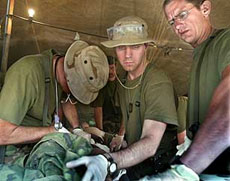 Iraqi war has lowest U.S. fatality rate
Iraqi war has lowest U.S. fatality rate
BY Ceci Connolly
WASHINGTON – Just 10 percent of soldiers injured in Iraq have died from their war wounds, the lowest casualty fatality rate ever, thanks in large part to technological advances and the deployment of surgical SWAT teams at the front lines, an analysis to be published today has found.
But the remarkable lifesaving rate has come at the enormous cost of creating a generation of severely wounded young veterans and a severe shortage of military surgeons, wrote Atul Gawande, a surgeon at Brigham and Women’s Hospital in Boston.
The war in Iraq has produced the “largest burden of casualties our military medical personnel have had to cope with since the Vietnam War,” said Gawande’s report in the New England Journal of Medicine. By contrast, 24 percent of soldiers wounded in the Vietnam War or the Persian Gulf War did not survive.
“It used to be our thinking that the number of deaths reflects the violence of the war,” Gawande said in an interview. “Now, the number of deaths reflects how well surgical teams are doing in saving lives.”
About 10,700 U.S. service members have been injured in Iraq and more than 1,000 of them killed in action, according to Defense Department statistics cited in the report. “This can no longer be described as a small or contained conflict,” Gawande wrote.
He praised the military’s strategy of positioning close to the fighting smaller, “leaner and more mobile” surgical teams with the ability to erect a battlefield hospital in less than an hour. Traveling in Humvees with hand-held ultrasound machines, portable ventilators, supplies of red blood cells and an array of surgical tools and pharmaceuticals, the teams focus on stabilizing patients and moving them for further treatment in less than two hours.
During the Vietnam War, it took injured soldiers an average of 45 days to reach a hospital in the United States. At the beginning of the Iraq war, the average was eight days, and now it is four. One airman hit by a mortar attack in September “was on the operating table at Walter Reed” Army Medical Center in Washington “just 36 hours later,” Gawande said.
The battlefield triage is called “damage control” because the emphasis is on stopping bleeding, keeping a patient warm and leaving almost everything else to doctors at a permanent hospital.
“The combination of Kevlar vests and a system that allows them to stop the bleeding makes it possible for them to survive injuries that were unsurvivable before,” he said. “How you rehabilitate physically, let alone emotionally, someone who has that kind of loss is a serious question.”
For every soldier killed, an average of 10 are injured, he said. Early in the conflict, when the fighting was more traditional battlefield combat, the most common injuries came from artillery wounds to limbs unprotected by body armor. More recently, as the engagement has shifted to guerrilla-style warfare with explosive devices, more injuries result from shrapnel that hits under vests and through neck and arm holes, Gawande said.
“And with suicide bombers you see not just metal shrapnel, but also clothing, dirt and even bone from the attacker that is infectious,” he said, “and can lead to more extensive surgeries and multiple surgeries.”
Military surgeons, like the armed forces as a whole, also are suffering with recruiting problems. The U.S. Army, for instance, has just 120 active-duty general surgeons. Many doctors are serving on repeated or extended deployments, and some specialists in fields such as urology have been deployed as general surgeons to alleviate shortages.
Gawande cautioned that the combat surgeons’ unprecedented success rate could suffer if the number of enlisted doctors doesn’t increase.
“I am worried about the military’s ability to continue operating at that level, given that they have a relatively small number of surgeons available to them,” he said. “These are not people you can get easily to go off to war.”
John Holcomb, commander of the U.S. Army Institute of Surgical Research and a trauma consultant to the Army’s Surgeon General, agreed that Iraq can no longer be viewed as a minor conflict. But he said the casualty rate and severity of injuries is not inconsistent with other wars.
A review of historical documents shows that “head and extremity injuries predominate, at least back to World War I, World War II, Korea and Vietnam,” he said. Perhaps Gawande, who lacks military experience, was unaccustomed to the level of trauma seen in war, he said.
“The injuries in combat are devastating compared to what most civilian surgeons are used to seeing,” he said, adding that the closest parallel he could think of were injuries sustained by someone run over by a train.
The number of general surgeons serving in Iraq is not as high as in the Persian Gulf War 13 years ago, Holcomb acknowledged, but said the key was placing the right doctors and nurses in the right place.
Iraq has brought other unanticipated medical challenges. Soldiers were suffering a “dismayingly high incidence of blinding injuries” because they refused to wear goggles that they described as “something a Florida senior citizen would wear.” So the military bowed to fashion, Gawande said, and purchased hipper eyewear that appears to be serving its purpose.
ATTENTION READERS
We See The World From All Sides and Want YOU To Be Fully InformedIn fact, intentional disinformation is a disgraceful scourge in media today. So to assuage any possible errant incorrect information posted herein, we strongly encourage you to seek corroboration from other non-VT sources before forming an educated opinion.
About VT - Policies & Disclosures - Comment Policy



